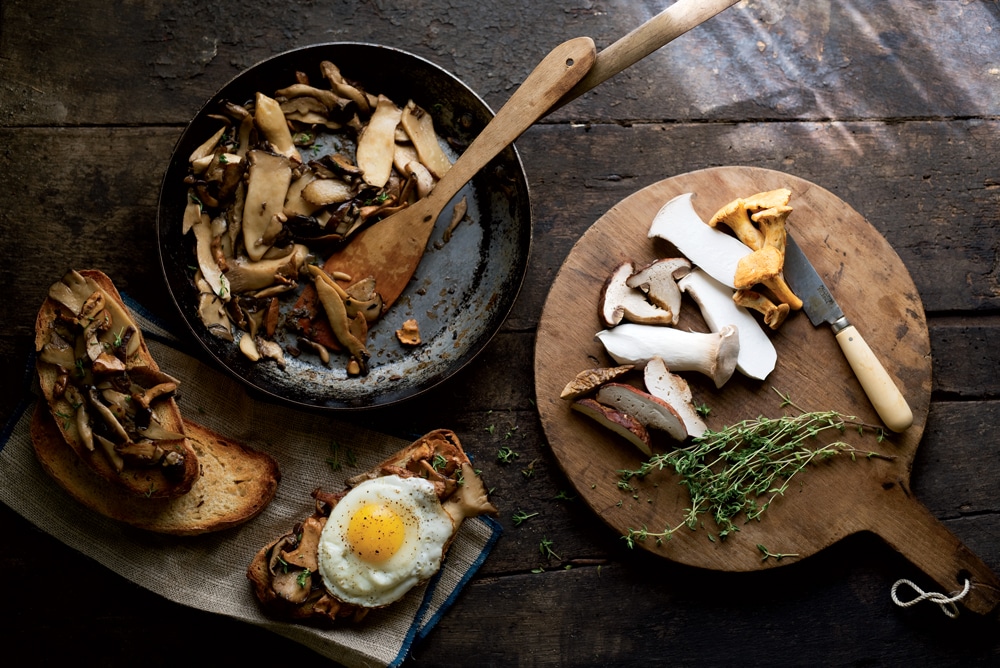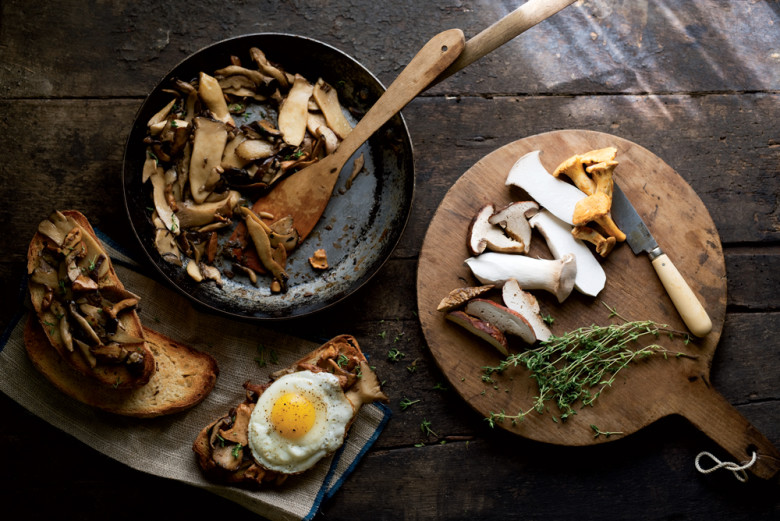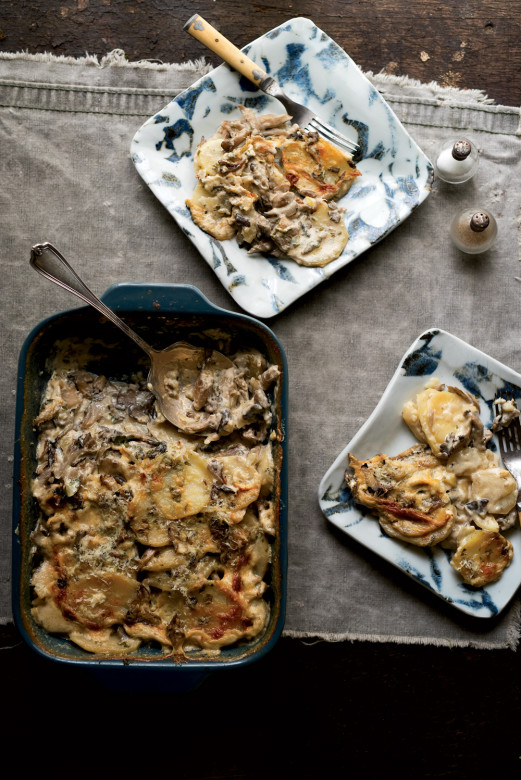Fruits of the Forest | Wild Mushroom Recipes
Make the most of fresh, wild mushrooms in these four flavorful recipes, including Potato and Wild Mushroom Gratin and Wild Mushroom Chowder.

Coffee By Design | Portland, Maine
Photo Credit : Katherine KeenanIt was just the three of us that day—a writer, a photographer, and a third-generation innkeeper—a trio of middle-aged men heading deep into the Maine woods.
Well, not too deep, really: We were on the outskirts of Portland, Maine, the scatterings of discarded beer cans and cigarette butts indicating the most recent wildlife in the area was likely a herd of drunken teenagers.

Photo Credit : Jamie Salomon
It was late October, and aside from the scrunch of our boots in the leaves there was barely a sound as we walked along steep cliffs rising from the Saco River and made knee-cracking jumps over shallow creek beds. Along the way, we talked a little—about our children, about the unsettling number of New Yorkers relocating to Portland—but our minds were only half-focused on these conversations. We were hunting, you see. Hunting for wild mushrooms.
Jamie Salomon, the photographer, declared that conditions weren’t great. Maine was experiencing a drought, which was making the fruits of the mycelium—aka mushrooms, which are drawn to the surface by moisture—hard to come by. And this was the tail end of the fall season, a last window of opportunity before deep frosts would put an end to any new growth. The spring morel season was long behind us; the slower, drier summer season expired. We hoped that a recent bout of rain would bring us some frilly brown hen of the woods, black trumpets, fragrant porcini, egg yolk–colored chanterelles, or bright red lobster mushrooms.
I’d driven from Brooklyn, New York, to join Jamie and his friend Pierre Janelle, the innkeeper, on my first-ever foraging mission. Jamie, who’s always had a taste for wild mushrooms, started foraging after taking a class with a local mycological society. He met Pierre, an avid home cook with a shared love of mushrooms, a few years back, and they’ve been at it ever since, spending weekends searching Maine’s forests—or sometimes just their neighbors’ yards—for their quarry.
On this day, Jamie was on the lookout for king boletes, the meaty American cousins of the Italian porcini, identifiable by the spongy bottoms of their caps. If lucky, he would also stumble upon some pungent matsutakes, the firm white mushrooms that are nothing short of sacred in Japanese cuisine and can fetch around $25 per pound from the Portland restaurants to which he occasionally sells his bounty.

Photo Credit : Jamie Salomon
The first lesson Jamie and Pierre shared with me is that there are certain signs, or “setups,” that’ll tell you which woods are conducive for foraging and which ones are a waste of time. “You want mature forests that are open, not full of thickets,” Jamie said. “Scrubby woods are no good.” The forest we’d chosen was perfect: It was rife with hemlocks and oaks, both of which have a symbiotic relationship with the mushrooms we sought. The mushrooms’ mycelia—fine underground networks of fungal threads—seek out tree roots, tapping their nutrients. In turn, the mushrooms help absorb water and minerals for the trees.
The second lesson: Mushroom foraging can be a tricky business. Ingesting the wrong kind can lead to anything from the mild (an upset stomach) to the hallucinatory to the downright deadly. “You’ll want to rule out any Amanita,” Jamie told me, referring to a genus of potentially toxic species that are identifiable by the small, egglike bulb seen once they’re picked from the ground. “I try to collect mushrooms that don’t have look-alikes, like black trumpets and hen of the woods.”
While none of the specimens we came across that day were deadly, some did have the potential to send us to bed with gastrointestinal distress. Case in point: On our drive to the woods, Pierre made us stop near a retirement home, thinking he spied some king boletes along its parking lot. On closer inspection, he realized the mushrooms were a species of Lactarius that would likely make you feel, as Jamie so eloquently put it, “as if you drank six daiquiris, and then threw up.”
It took only 10 minutes in the woods with Jamie and Pierre until I was hooked. The longer we walked, the more my focus shifted away from the trees and creeks and rocks, and toward the forest floor and the fungi below. Before long, that was all I could see.

Photo Credit : Jamie Salomon
I was electrified when I came across a huge outcropping of bright yellow fungi on a fallen log, thinking they were chanterelles. But when I called Jamie and Pierre over to have a look, they were unimpressed. “Honey mushrooms,” Jamie proclaimed. He later told me that while a lot of people love eating honey mushrooms—they’re a popular filling for pierogi in Ukraine—he’s never given them much thought. “It’s like fish. There are hundreds of species out there, but there are only a few that most people are interested in eating.” He had the same reaction when we stumbled upon a crop of inky caps. “I don’t collect those,” Jamie said. “If you eat them with alcohol, they’ll make you sick—and I like to drink.”
After an hour and a half of hunting, we left the woods empty-handed. But when we got to Jamie’s car, he opened the trunk to reveal a magnificent 35-pound hen of the woods that looked to be the size of a small asteroid. “I found it in front of a house in Kittery, right along Route 1,” he said. And while I’d never had this sort of reaction to a 35-pound heap of fungi before, my mouth began to water. He told me that he was going to sell it to a chef he knew, but that he’d already shaved a bit off and pickled it.
Back at his house, Jamie shared some of that pickled mushroom with me—which made me realize I needed to make more room in my life for pickling mushrooms. As I was leaving, I asked what he was up to for the rest of the weekend. He said he’d seen a chicken of the woods (not to be confused with a hen of the woods) growing on a neighbor’s tree; he was going to drive over with a ladder and cut it down.
Heading back to my hotel, I could hardly keep my eyes on the road. All I could see were mushrooms. A few days later, the jar of pickled mushrooms in my refrigerator was ready to eat, a memory of the Maine woods kept alive in my city kitchen.
The following recipes can all be made with mushrooms commonly found in supermarkets: button, portobello, shiitake, oyster, and “mixed wild” varieties. If using wild mushrooms, be sure to source them from a reputable forager. Better yet, enroll in a mushroom identification course through your local extension program or mycological society.








Great info on selecting and foraging for the right mushrooms!